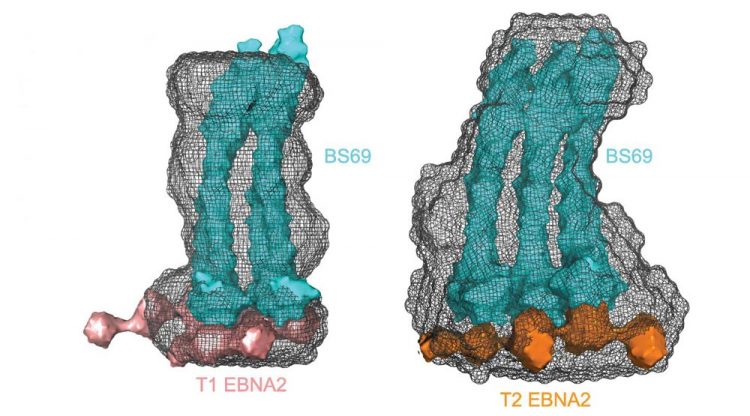Genetic differences between strains of Epstein-Barr virus can alter its activity

Solution structures of type 1 and type EBV EBNA2-BS69 complexes determined by small angle X-ray scattering. Type 2 EBNA2 binds an extra BS69 molecule (dimer). Credit: Michelle West, University of Sussex
Researchers at the University of Sussex have identified how differences in the genetic sequence of the two main strains of the cancer-associated Epstein-Barr virus (EBV) can alter the way the virus behaves when it infects white blood cells.
When EBV enters white blood cells it drives them to grow rapidly and continuously, making them 'immortal'. In some cases this can lead to the development of lymphoma, a type of blood cancer.
There are two main strains of the virus worldwide and although they can both cause cancer, in the laboratory, one strain (type 1) is able to drive white blood cells to become immortal better than the other (type 2).
While scientists already knew that the different properties of the two strains were caused by a protein called EBNA2, which is produced by EBV, until now they didn't know how it could cause the viruses to act so differently.
In a new research paper published in the journal PLOS Pathogens, Professor Michelle West together with Dr Erika Mancini at the University of Sussex and Professor Paul Farrell at Imperial College London, have identified a molecular reason for the difference in activity between the two strains.
Prof West said: “EBNA2 is kept in check by contact with a protein normally found in white blood cells; BS69. This contact damps down EBNA2 function but does not block it entirely.
“While type 1 has two contact points for BS69 the sequence changes in type 2 result in the creation of a third contact point.
“This additional contact damps down type 2 EBNA2 function to a greater extent, helping to explain why this strain of EBV is less efficient at driving white blood cell growth.”
The research, funded by the charity Bloodwise and the Medical Research Council helps shed light on how proteins already present in white blood cells can restrict some strains of the virus more than others.
Prof. West said: “It is assumed that because type 2 strains of EBV are less efficient in the laboratory, these strains of EBV might be less cancer promoting, but oddly there is no evidence to support this.
“We do know that type 2 strains of EBV are more common in certain parts of Asia and Africa, and we could speculate that immortalising white blood cells less efficiently may somehow be an advantage to the virus in infecting people in these parts of the world.
“New research also shows that type 2 strains of EBV are able to infect a different kind of white blood cell, the T cell, so it may be that type 2 strains use an alternative route to enter the body.”
Professor West's team, in collaboration with Professor Farrell and Dr White at Imperial College, will now investigate the impact of strain variation on the biology of EBV further, thanks to recent funding for a 3-year project by the Medical Research Council.
Media Contact
More Information:
https://www.sussex.ac.uk/news/research?id=49120All latest news from the category: Health and Medicine
This subject area encompasses research and studies in the field of human medicine.
Among the wide-ranging list of topics covered here are anesthesiology, anatomy, surgery, human genetics, hygiene and environmental medicine, internal medicine, neurology, pharmacology, physiology, urology and dental medicine.
Newest articles

Silicon Carbide Innovation Alliance to drive industrial-scale semiconductor work
Known for its ability to withstand extreme environments and high voltages, silicon carbide (SiC) is a semiconducting material made up of silicon and carbon atoms arranged into crystals that is…

New SPECT/CT technique shows impressive biomarker identification
…offers increased access for prostate cancer patients. A novel SPECT/CT acquisition method can accurately detect radiopharmaceutical biodistribution in a convenient manner for prostate cancer patients, opening the door for more…

How 3D printers can give robots a soft touch
Soft skin coverings and touch sensors have emerged as a promising feature for robots that are both safer and more intuitive for human interaction, but they are expensive and difficult…





















